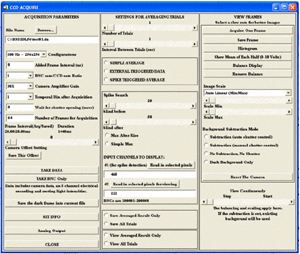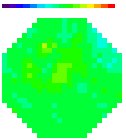Main
Features
·
Simultaneous optical and 8 channels of electrical recording
· Software control of a shutter and a stimulator
· 3 available modes for triggering of acquisition/averaging:
· Analogue output for voltage commands
 |
User Interface
The
acquisition interface is system dependent. The acquisition interface
for a NeuroCCD-SMQ system is shown in the picture. A variety of options
exist for acquisition, including three major acquisition/averaging
protocols.
NeuroPlex
software also controls various aspects of the experiment, such as the
shutter, the stimulator, and the camera fans (NeuroCCD). |
Additional
Information

The data
acquisition software is specific to a particular PC based
analogue-to-digital converter card. Some capabilities of the
acquisition section are:
Signal
Averaging:
Three types
of averaging are available.
1.
Averaging from a trigger provided by the computer.
2. Averaging from the
occurrence of a spike on one of the recorded channels.
3. Averaging from the
occurrence of an external event such as the EKG.
(NeuroPDA only)
In this mode, alternate trials with and without a stimulus can be
subtracted to reduce heart-beat artifacts.
Subset:
For the
Photodiode array system a Subset or Binning of the diodes can be
selected for acquisition. Using a subset allows an increase in the
frame rate above 1.6 kHz and/or a reduction in the size of the
resulting data file. For NeuroCCD 2x2 binning can be used to increase
the frame rate, reduce the data storage requirements, and/or reduce the
relative dark-noise contribution
Resting Light
Intensity:
The DC level of
the amplifier output can be measured directly or can be measured after
subtracting the DC level with no light.
Other
parameters under the user's control are:
1.
file name,
2. number of points (frames)
per detector,
3. frame interval,
4. number of trials (for
averaging),
5. interval between trials (for
averaging),
6. and interval between light
on and start of sampling.
|



